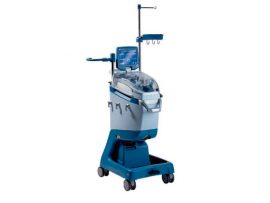Abstract Objective To compare immediate postoperative results in patients receiving heparin-albumin-coated and non-coated circuits. Methods A total of 241 patients undergoing on-pump cardiac surgery were divided into two groups: those..
Read MoreAbstract Objective Conventional ultrafiltration (CUF) during cardiopulmonary bypass (CPB) serves to hemoconcentrate blood volume to avoid allogeneic blood transfusions. Previous studies have determined CUF volumes as a continuous variable are..
Read MoreAbstract A 34-year-old African American man was brought to the trauma resuscitation area with 2 gunshot wounds to his right anterior chest below his clavicle and his left back. On..
Read MoreAbstract Different arterial cannulation strategies are feasible for veno-arterial extracorporeal membrane oxygenation (VA-ECMO) in postcardiotomy shock. We aimed to analyze potential benefits and safety of different arterial cannulation strategies. We..
Read MoreBackground It is unclear whether high-dose regimens of tranexamic acid in cardiac surgery (total dose, 80 to 100 mg/kg) confer a clinical advantage over low-dose regimens (total dose, approximately 20..
Read MoreAbstract Objective Preoperative anemia management reduces red blood cell (RBC) transfusion and adverse outcomes, but how best to optimize the patient’s hemoglobin (Hgb) before cardiac surgery remains unclear. The authors..
Read MoreAbstract Introduction Anemia and blood transfusion are risk factors for morbidity/mortality in patients undergoing cardiac surgery with cardiopulmonary bypass (CPB). The objective of this study is to analyze the association..
Read MoreAbstract Bleeding following cardiac surgery that warrants transfusion of blood products is associated with significant complications, including increased mortality at 1 year following surgery. Factor concentrates, such as prothrombin complex..
Read MoreAbstract Bleeding caused by coagulopathy is common in children undergoing cardiac surgery and causes adverse outcomes. Coagulation testing assists selection of treatments to stop bleeding but has an uncertain role..
Read MoreSummary Despite current recommendations on the management of severe peri‐operative bleeding, there is no pragmatic guidance for the peri‐operative monitoring and management of cardiac surgical patients taking direct oral anticoagulants...
Read MoreAbstract Introduction Paediatric patients are particularly prone to cardiopulmonary bypass (CPB)‐induced coagulopathy mainly due to haemodilution, consumption of coagulation factors and hypothermia. The aim of the present study was to..
Read MoreABSTRACT Background: Blood transfusions are the most common type of tissue and organ transplantation. Perioperative and postoperative transfusions may cause morbidity and mortality and transfusion should based on only hematocrit values..
Read MoreAbstract The aim of this study was to evaluate the impact of blood transfusion on bloodstream infections. This study included 2764 patients who underwent isolated coronary artery bypass grafting. Blood..
Read MoreSummary Anaemia is common before cardiac surgery and is associated with increased morbidity and mortality. The World Health Organization (WHO) definition of anaemia is lower for women than for men..
Read MoreAbstract Background There is still uncertainty about the safety of aprotinin for coronary artery bypass graft surgery. The ART (Arterial Revascularization Trial) was designed to compare survival after bilateral versus..
Read MoreAbstract Background Acute normovolemic hemodilution (ANH) is considered safe and effective in decreasing perioperative transfusion in paediatric populations undergoing high blood‐loss surgeries. We determined the association between ANH and the..
Read MoreAbstract Introduction: Accurate dosing of protamine reversal following on-pump cardiac surgical procedures is challenging, with both excessive and inadequate administration recognised to increase bleeding risk. We aimed to examine the..
Read MoreAbstract Background: Cardiac surgery on Jehovah's Witnesses (JW) can be challenging, given the desire to avoid blood products. Establishment of a blood conservation program involving the pre-, intra- and post-operative..
Read MoreAbstract Editor’s Perspective What We Already Know about This Topic Major bleeding can occur during cardiac surgery. Although different scoring systems exist, the assessment of bleeding can be variable, and..
Read MoreAbstract OBJECTIVES Minimally invasive aortic valve replacement (MIAVR) can be technically demanding and may lead to prolonged operative time. We evaluated the intraoperative and postoperative patient outcomes following implementation of..
Read MoreAbstract Background: The aim of the present study was to investigate the relationship between maximum clot firmness (MCF) in rotational thromboelastometry (ROTEM®) and postoperative bleeding in patients on clopidogrel after..
Read MoreAbstract Minimal invasive extracorporeal circulation (MiECC) has initiated important new efforts within science and technology towards a more physiologic perfusion. In this study, we aim to investigate the learning curve..
Read MoreAbstract The use of cell salvage is recommended when it can be expected to reduce the likelihood of allogeneic (donor) red cell transfusion and/or severe postoperative anaemia. We support and..
Read MoreAbstract Background Adult cardiac surgery with extracorporeal circulation is known to be associated with increased risk of blood transfusion leading to adverse outcomes. Procedures like retrograde autologous priming (RAP) may..
Read MoreAbstract Background Fish oil is among the most common natural supplements for treatment of hypertriglyceridemia or prevention of cardiovascular disease. However, concerns about theoretical bleeding risk have led to recommendations..
Read MoreAbstract Background: Cardiac surgery is associated with peri-operative bleeding, which may result in the need for blood transfusion, particularly in paediatric congenital cardiac surgery on cardiopulmonary bypass (CPB). There is..
Read MoreAbstract Background Acute normovolemic hemodilution is recommended as a technique to reduce allogeneic red blood cell (RBC) transfusions in cardiac surgery, but its efficacy to reduce non‐RBC transfusion has not..
Read MoreAbstract Since 2013, rotational thromboelastometry has been available in our hospital to assess coagulopathy. The aim of the study was to retrospectively evaluate the effect of thromboelastometry testing in cardiac..
Read MoreAbstract Objectives Rotational (ROTEM)-guided transfusion algorithms in cardiac surgery have been proven to be successful in reducing blood loss in randomized controlled trials. Using an institutional registry of patients in cardiac surgery..
Read MoreAbstract Introduction In modern surgical era, local haemostatic agents and blood components such as recombinant activated factor VII (rFVIIa) have expanded surgeons’ armamentarium in controlling “surgical” and “nonsurgical bleeding”. We..
Read More















